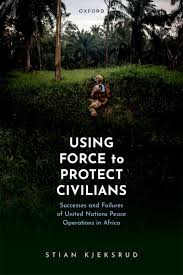Using force to protect civilians
successes and failures of United Nations peace operations in Africa
- ISBN: 9780192857101
- Editorial: Oxford University Press
- Fecha de la edición: 2024
- Lugar de la edición: Oxford. Reino Unido
- Encuadernación: Cartoné
- Medidas: 24 cm
- Nº Pág.: 256
- Idiomas: Inglés

Using Force to Protect Civilians offers the first comprehensive analysis of United Nations military protection operations across time and UN missions, drawing on a novel dataset that covers 200 operations from ten UN peacekeeping missions in Africa from 1999 to 2017. Employing a mixed-methods research design, the book finds that Blue Helmets succeed as often as they fail when they employ force to protect, indicating that they can wield force effectively - under the right conditions - to achieve this priority task. Stian Kjeksrud shows that effective UN military protection operations must rest on a deep understanding of perpetrators' motivation and modus operandi for attacking civilians, facilitating tailored military responses to stop or reduce physical threats in a timely manner. Adding to existing knowledge about the conflict-reducing effect of the presence of uniformed UN personnel, he also finds that specific actions matter more than the simple presence of Blue Helmets in large numbers. While protecting civilians is a priority task for military peacekeepers, we have limited knowledge about how they fare across time and in different UN missions when they use force to protect. We also remain largely ignorant of the conditions leading to successful outcomes when they intervene militarily to protect civilians from violence. Using Force to Protect Civilians addresses both of these knowledge gaps, and provides the building blocks for a theory of the utility of force to protect civilians in UN peace operations.
1. Protection by military force in UN peace operations
The book in a nutshell
Defining success in UN military protection operations
Unpacking UN military protection operations
Understanding the perpetrators to tailor effective operations
So what?
Outline of the book
2. Understanding the utility of force to protect civilians from violence
Four causal condition candidates
Causal mechanisms and hypotheses Further deliberations on the matching theory
Summary of causal condition candidates
3. Exploring characteristics and outcomes of UN military protection operations
Characteristics of UN military protection operations
Summary of descriptive statistics
Estimating outcomes of UN military protection operations (1999-2017)
4. Analyzing empirical patterns of UN military protection operations
Operationalization of causal condition candidates
Bivariate cross-tabulations
Summary of cross-tabulations
Multivariate linear probability analysis 5. Discovering causal pathways to successful protection outcomes
Qualitative Comparative Analysis
The outcome
Causal condition candidates
Necessary conditions for successful outcomes
Causal recipes toward successful outcomes
6. Protecting Civilians from the M23
Matching the M23
Pre-empting the M23
Troop-to-perpetrator ratios
Willingness to accept risk
Additional explanations for the successful outcome
Conclusion
7. Overwhelmed by the White Army
Failing to match the White Army
The absence of relevant responses to Murle revenge attacks
Pre-emption Troop-to-perpetrator ratios
Willingness to accept risk
Additional explanations for the unsuccessful outcome
Conclusion
8. Increasing the utility of force to protect
Summary of main findings
Implications for theory, policy, and practice of UN military protection operations






